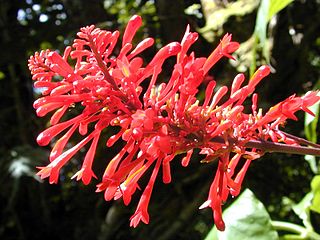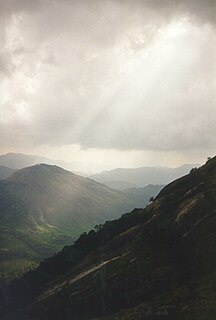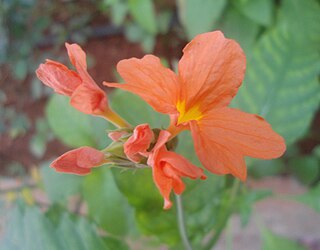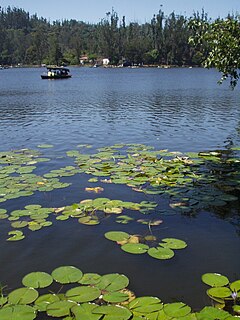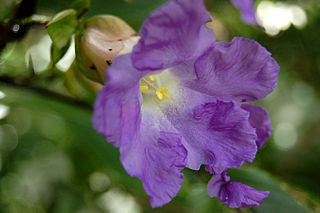| Strobilanthes kunthianus | |
|---|---|
 | |
| Scientific classification | |
| Kingdom: | |
| (unranked): | |
| (unranked): | |
| (unranked): | |
| Order: | |
| Family: | |
| Genus: | |
| Species: | S. kunthianus |
| Binomial name | |
| Strobilanthes kunthianus (Wall. ex Nees) T. Anders. ex Benth. | |
Kurinji or Neelakurinji (Strobilanthes kunthianus) is a shrub that is found in the shola forests of the Western Ghats in South India. Nilgiri Hills, which literally means the blue mountains, got their name from the purplish blue flowers of Neelakurinji that blossoms only once in 12 years. Of all long interval bloomers (or plietesials) Strobilanthes kunthianus is the most rigorously demonstrated, with documented bloomings in 1838, 1850, 1862, 1874, 1886, 1898, 1910, 1922, 1934, 1946, 1958, 1970 [1] 1982, 1994, 2006 and 2018

A shrub or bush is a small- to medium-sized woody plant. Unlike herbaceous plants, shrubs have persistent woody stems above the ground. They are distinguished from trees by their multiple stems and shorter height, and are usually under 6 m (20 ft) tall. Plants of many species may grow either into shrubs or trees, depending on their growing conditions. Small, low shrubs, generally less than 2 m (6.6 ft) tall, such as lavender, periwinkle and most small garden varieties of rose, are often termed "subshrubs".
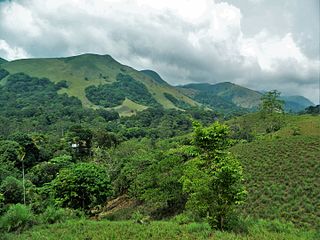
Sholas are the local name for patches of stunted tropical montane forest found in valleys amid rolling grassland in the higher montane regions of South India. These patches of shola forest are found mainly in the valleys and are usually separated from one another by undulating montane grassland. The shola and grassland together form the shola-grassland complex or mosaic. The word 'Shola' is probably derived from the Tamil language word cÕlai (சோலை) meaning grove. The shola-forest and grassland complex has been described as a climatic climax vegetation with forest regeneration and expansion restricted by climatic conditions such as frost or soil characteristics while others have suggested that it may have anthropogenic origins in the burning and removal of forests by early herders and shifting agriculturists.

Western Ghats also known as Sahyadri is a mountain range that covers an area of 140,000 km² in a stretch of 1,600 km parallel to the western coast of the Indian peninsula, traverse the States of Kerala, Tamil Nadu, Karnataka, Goa, Maharashtra and Gujarat. It is a UNESCO World Heritage Site and is one of the eight "hottest hot-spots" of biological diversity in the world. It is sometimes called the Great Escarpment of India. It is a biodiversity hotspot that contains a large proportion of the country's flora and fauna; many of which are only found in India and nowhere else in the world. According to UNESCO, Western Ghats are older than Himalayan mountains. It also influences Indian monsoon weather patterns by intercepting the rain-laden monsoon winds that sweep in from the south-west during late summer. The range runs north to south along the western edge of the Deccan Plateau, and separates the plateau from a narrow coastal plain, called Konkan, along the Arabian Sea. A total of thirty-nine areas including national parks, wildlife sanctuaries and reserve forests were designated as world heritage sites - twenty in Kerala, ten in Karnataka, five in Tamil Nadu and four in Maharashtra.
Contents
- Description
- Masting
- Habitat
- Conservation
- References in literature
- See also
- References
- External links
Other Kurinji species, such as Strobilanthes cuspidatus , bloom once every seven years, and then die. Their seeds subsequently sprout and continue the cycle of life and death. [2]
The Paliyan tribal people living in Tamil Nadu used it as a reference to calculate their age. [3] This plant flowers during September-October.
The Paliyan, or Palaiyar or Pazhaiyarare are a group of around 9,500 formerly nomadic Dravidian tribals living in the South Western Ghats montane rain forests in South India, especially in Tamil Nadu and Kerala. They are traditional nomadic hunter-gatherers, honey hunters and foragers. Yams are their major food source. In the early part of the 20th century the Paliyans dressed scantily and lived in rock crevices and caves. Most have now transformed to traders of forest products, food cultivators and beekeepers. Some work intermittently as wage laborers, mostly on plantations. They are a Scheduled Tribe. They speak a Dravidian language, Paliyan, closely related to Malayalam.



